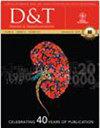{"title":"血管通路的决定因素:患者特征还是医生偏好?","authors":"Megha Shah MD, Vijay Jain MD, Lori Spalding MD, Wajid Choudhry MD","doi":"10.1002/dat.20593","DOIUrl":null,"url":null,"abstract":"BACKGROUND \n \nThe goal of the Fistula First Initiative is to increase the use of arteriovenous fistula (AVF) for dialysis to 66% of total dialysis patients. Most facilities fall short of this target. Our objective is to determine the impact of provider bias in influencing the rate of AVF in dialysis facilities. \n \n \n \nMETHODS \n \nWe retrospectively studied 176 patients who received a new vascular access for dialysis over 18 months in two groups. In one group, a single surgeon was involved in vascular access placement (56 patients), while the other group had multiple surgeons (120 patients). \n \n \n \nRESULTS \n \nA significantly higher number of patients received AVF as their primary vascular access in the single-surgeon group, even though there were no significant differences in age, gender, and co-morbidities in the two groups. There was no difference in primary and secondary fistula failure rates. \n \n \n \nCONCLUSIONS \n \nOur study shows that AVF rate varies in different dialysis units, involving different providers, despite similar patient profiles. This implies the presence of a possible bias among providers when selecting a patient for type of access. Thus a higher rate of AVF placement, closer to the target rate, can be achieved by removing this bias. Dial. Transplant. © 2011 Wiley Periodicals, Inc.","PeriodicalId":51012,"journal":{"name":"Dialysis & Transplantation","volume":"40 9","pages":"410-412"},"PeriodicalIF":0.0000,"publicationDate":"2011-09-12","publicationTypes":"Journal Article","fieldsOfStudy":null,"isOpenAccess":false,"openAccessPdf":"https://sci-hub-pdf.com/10.1002/dat.20593","citationCount":"0","resultStr":"{\"title\":\"Determinants of vascular access: Patient characteristics or physician preference?\",\"authors\":\"Megha Shah MD, Vijay Jain MD, Lori Spalding MD, Wajid Choudhry MD\",\"doi\":\"10.1002/dat.20593\",\"DOIUrl\":null,\"url\":null,\"abstract\":\"BACKGROUND \\n \\nThe goal of the Fistula First Initiative is to increase the use of arteriovenous fistula (AVF) for dialysis to 66% of total dialysis patients. Most facilities fall short of this target. Our objective is to determine the impact of provider bias in influencing the rate of AVF in dialysis facilities. \\n \\n \\n \\nMETHODS \\n \\nWe retrospectively studied 176 patients who received a new vascular access for dialysis over 18 months in two groups. In one group, a single surgeon was involved in vascular access placement (56 patients), while the other group had multiple surgeons (120 patients). \\n \\n \\n \\nRESULTS \\n \\nA significantly higher number of patients received AVF as their primary vascular access in the single-surgeon group, even though there were no significant differences in age, gender, and co-morbidities in the two groups. There was no difference in primary and secondary fistula failure rates. \\n \\n \\n \\nCONCLUSIONS \\n \\nOur study shows that AVF rate varies in different dialysis units, involving different providers, despite similar patient profiles. This implies the presence of a possible bias among providers when selecting a patient for type of access. Thus a higher rate of AVF placement, closer to the target rate, can be achieved by removing this bias. Dial. Transplant. © 2011 Wiley Periodicals, Inc.\",\"PeriodicalId\":51012,\"journal\":{\"name\":\"Dialysis & Transplantation\",\"volume\":\"40 9\",\"pages\":\"410-412\"},\"PeriodicalIF\":0.0000,\"publicationDate\":\"2011-09-12\",\"publicationTypes\":\"Journal Article\",\"fieldsOfStudy\":null,\"isOpenAccess\":false,\"openAccessPdf\":\"https://sci-hub-pdf.com/10.1002/dat.20593\",\"citationCount\":\"0\",\"resultStr\":null,\"platform\":\"Semanticscholar\",\"paperid\":null,\"PeriodicalName\":\"Dialysis & Transplantation\",\"FirstCategoryId\":\"1085\",\"ListUrlMain\":\"https://onlinelibrary.wiley.com/doi/10.1002/dat.20593\",\"RegionNum\":0,\"RegionCategory\":null,\"ArticlePicture\":[],\"TitleCN\":null,\"AbstractTextCN\":null,\"PMCID\":null,\"EPubDate\":\"\",\"PubModel\":\"\",\"JCR\":\"\",\"JCRName\":\"\",\"Score\":null,\"Total\":0}","platform":"Semanticscholar","paperid":null,"PeriodicalName":"Dialysis & Transplantation","FirstCategoryId":"1085","ListUrlMain":"https://onlinelibrary.wiley.com/doi/10.1002/dat.20593","RegionNum":0,"RegionCategory":null,"ArticlePicture":[],"TitleCN":null,"AbstractTextCN":null,"PMCID":null,"EPubDate":"","PubModel":"","JCR":"","JCRName":"","Score":null,"Total":0}
引用次数: 0
Determinants of vascular access: Patient characteristics or physician preference?
BACKGROUND
The goal of the Fistula First Initiative is to increase the use of arteriovenous fistula (AVF) for dialysis to 66% of total dialysis patients. Most facilities fall short of this target. Our objective is to determine the impact of provider bias in influencing the rate of AVF in dialysis facilities.
METHODS
We retrospectively studied 176 patients who received a new vascular access for dialysis over 18 months in two groups. In one group, a single surgeon was involved in vascular access placement (56 patients), while the other group had multiple surgeons (120 patients).
RESULTS
A significantly higher number of patients received AVF as their primary vascular access in the single-surgeon group, even though there were no significant differences in age, gender, and co-morbidities in the two groups. There was no difference in primary and secondary fistula failure rates.
CONCLUSIONS
Our study shows that AVF rate varies in different dialysis units, involving different providers, despite similar patient profiles. This implies the presence of a possible bias among providers when selecting a patient for type of access. Thus a higher rate of AVF placement, closer to the target rate, can be achieved by removing this bias. Dial. Transplant. © 2011 Wiley Periodicals, Inc.



